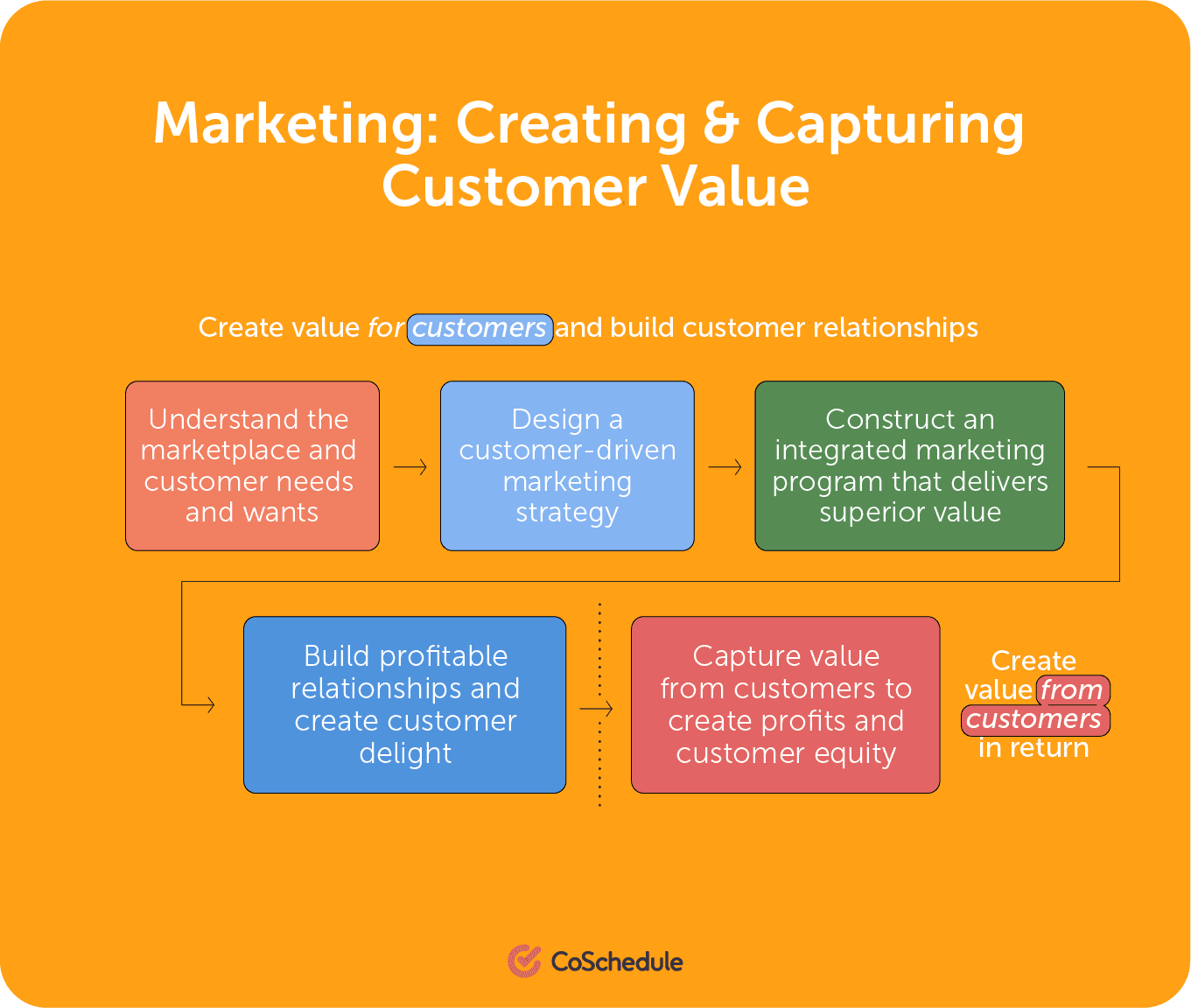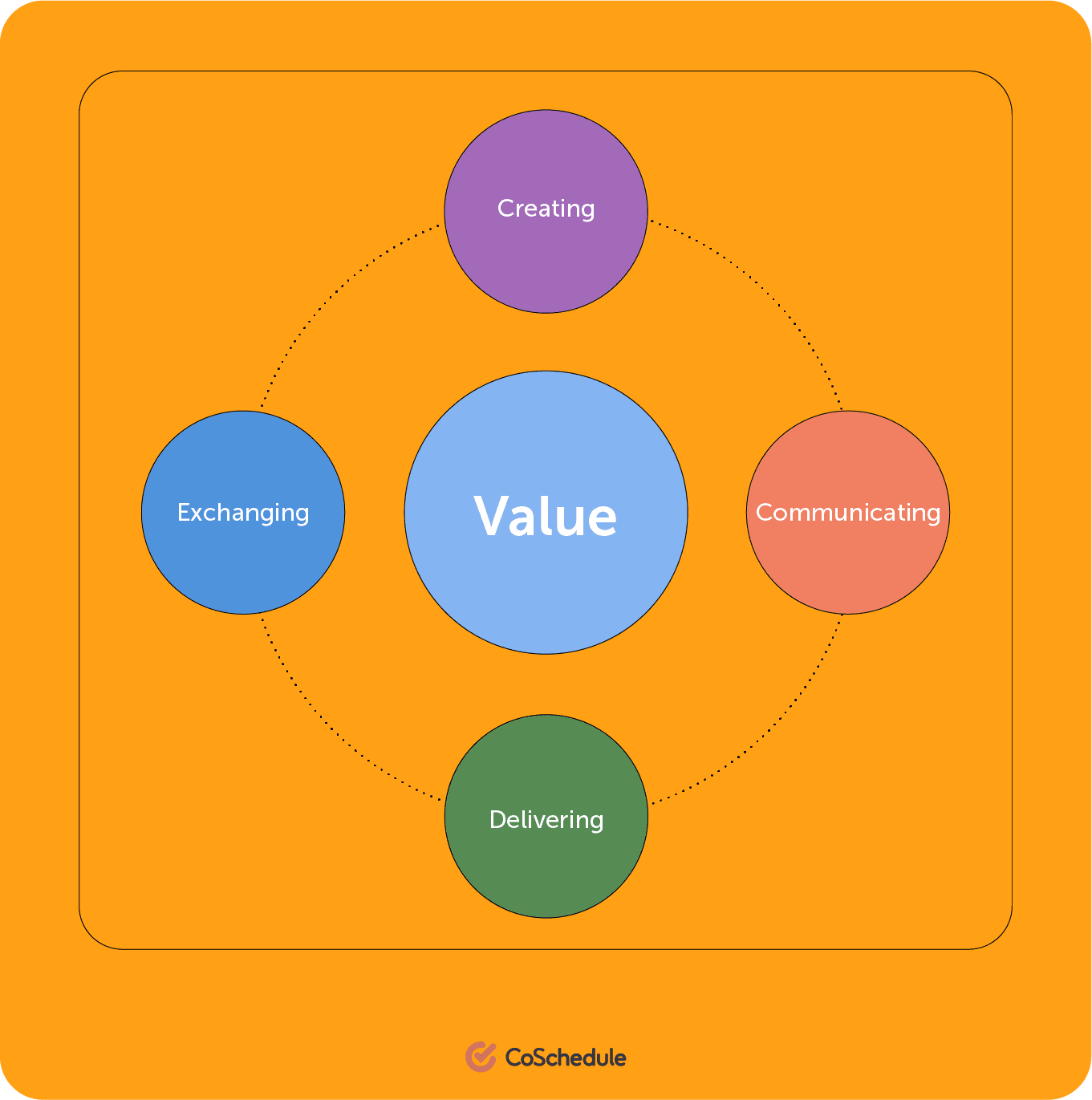Common principles of marketing include the marketing mix, marketing value principles, and the marketing activity principles that lead to customer value.
Marketing is much more than designing cool advertisements to sell products, contrary to what many of us were taught in school. Lots of planning goes into efficient marketing, so much so that it becomes a complex beast of tactics, studies, and strategies.
The marketing mix is all the tools marketers employ to build fantastic frameworks and foundations for their sales strategies.
It goes hand-in-hand with the seven Ps of marketing, the five value principles of the marketing process, and the four activity principles of marketing.

1. Product
The principles of marketing start with the product you are selling. This includes all the features of your product, the benefits it offers customers, and why they would want to buy it from you.
When you market your product, you’ll have to remember why customers want or need it and how to tell them they want or need it.
For this principle, there are a few factors to keep in mind:
- Your target market
- Your product range
- The quality of your product
- All the product’s features
- The benefits your product offers customers
- The size and design of the product
- Any extras and add-ons like special guarantees
2. Price
The second P you need to know about is the price of your product. It’s essential that you continuously keep an eye on the price so that it accurately reflects the current market. You may need to lower your price sometimes, and at other times, you can raise the price of your product or service.
There are different approaches you can take to pricing, with four of them standing out as the most effective:
- Discounts – Encourage buyers to buy your product by offering it at a lower price while ensuring they know the quality remains the same.
- Odd Pricing – Offer your product at just below its average price to make buyers that are price-sensitive think they’re getting it at a ‘bargain’ price.
- Synchro-pricing – Use your product’s price to manage the demand for it by making the most of customer sensitivity price.
- Penetration pricing – Introduce a new product or service at a lower price to test the market and stimulate widespread use.
3. Place
This P refers to where and how you will display and sell your product. Your customers should never be confused about how to get their hands on your product. You must know your target audience to choose the right place to sell your product — where it will get the most attention from the right people.
There is a wrong and a right place for everything, including your product. Remember the following:
- Where your customers will be looking for your product
- Where your target market spends most of their time
- How you present your product in the most convenient manner
4. Promotion
The fourth P that forms the principles of marketing refers to the promotion efforts you put in. This includes all your methods to inform customers of your product and how you try to encourage them to buy it.
Marketing your product can be done in many ways. Keep your target market in mind when choosing the best approach from the following:
- Direct selling
- Sales promotions
- Publicity campaigns in partnership with celebs or public figures
- Traditional and social media advertisements
5. People
From the marketing mix and marketing principles perspective, people refer to anyone involved in your business. Your staff, salespeople, market researchers, customer service team, and even yourself, are included in this category.
For marketing success, you need to have the right people at your side and behind the scenes.
Your teams should be trained in dealing with customers. You must ensure they are trained in:
- Technical Skills – Your team should know your product inside and out. They need to be able to answer any questions customers may have about how it works, what its benefits are, etc.
- Interpersonal Skills – Your front-end employees must be good at dealing with customers and be well-prepared for any social situation.
6. Process
Everything that goes into getting your product to your customers must be effective and efficient. If you have a good process in place, you’ll consistently give your customers the same standard of service.
Important Considerations:
- Processes must be well-controlled for consistent customer experience
- Processes should be well-defined in SOP (Standard Operating Procedure) documents
- Processes must be streamlined for service delivery
7. Packaging/Physical Evidence
The last P that makes up the principles of marketing refers to the packaging of your product and your company. It is everything that your customers see when they are interacting with your brand. You must always look at it with a critical eye to ensure it’s accurately representing your brand.
Here are some of the packaging/physical evidence elements to focus on:
- Your brand’s overall design and theme
- Your website
- The design of your physical shop
- The signage you use
- Brochure and similar advertising designs
In the book Principles of Marketing by Kotler and Armstrong, there are five value themes:
5 Value Themes
- “Creating value for customers in order to capture value from customers in return.”
- “Building and managing strong, value-creating brands.”
- “Measuring and managing return on marketing.”
- “Harnessing new marketing technologies.”
- “Sustainable marketing around the globe.”
These fundamental principles of marketing all relate to the marketing process:
Understand the marketplace and customer needs and wants → Design a customer-driven marketing strategy → Construct an integrated marketing program that delivers superior value → Build profitable relationships and create customer delight → Capture value from customers to create profits and customer equity

Source: Principles of Marketing by Kotler and Armstrong
1. Understand The Marketplace & Customer Needs & Wants
Without a good understanding of your marketplace and your customers, you can’t hope to build marketing strategies that will actually work successfully.
You must know everything about your customers’ wants and needs and what the marketplace looks like from the perspective of your company and industry. For this purpose, in-depth customer data and marketing research is necessary.
Understand the difference between wants, needs, and demands:
- Needs – Requirements that are essential and must be met, like being thirsty or hungry
- Wants – Desires that go beyond simply satisfying a basic need (like drinking a cold soda when thirsty)
- Demands – When buyers want specific products that they feel they want or need and are willing to pay for them
2. Design A Customer-Driven Marketing Strategy
All good marketing strategies have one thing in common: they’re customer-driven.
To ensure that your strategies are focused on your customers, you should select the customers you want to serve to have a good definition of your target market. Then you’ll embrace a value proposition and focus on getting it perfectly right.
A customer-driven marketing strategy requires the following from you:
- Ability to analyze your industry or niche and build detailed buyer personas
- Being wise enough to use customer feedback
- Investing in superb customer service
3. Construct An Integrated Marketing Program That Delivers Superior Value
Next, you need to build plans on how you’ll provide your customers with the quality they expect. This program should incorporate the principles of product, price, place, and promotion. You’ll also need a comprehensive understanding of your target audience.
There are many benefits to delivering value to your customers, including:
- Satisfied customers will share their experience
- Your brand’s image will improve
- Word-of-mouth will be positive
4. Build Profitable Relationships & Create Customer Delight
If you want your business to grow and thrive, you’ll need to build good relationships with your customers. Although getting new customers is ideal, most of your sales and support will come from returning customers.
Ensure that your customers are happy with your product and customer service so they’ll keep coming back for more.
Building good relationships with your customers requires dedication from you, and you should:
- Be adaptable
- Offer an easy way for your customers to provide feedback
- Focus on personalizing customers’ experiences
5. Capture Value From Customers To Create Profits & Customer Equity
You want your customer to be loyal — they should continue to buy from you for the rest of their lives, if feasible. This results in outstanding customer equity, and to do that, you need excellent customer relationship management. Customers should always be treated as the most important persons in the world.
To successfully capture value from your customers, you need to:
- Understand what drives value for them
- Have a clear understanding of your value proposition
- Know how you compare to your competition in the eyes of your customers
Marketing creates value for customers when their perceived benefits outweigh the costs of products or services.
Marketing value breaks down into four key types:
- Functional Value: These refer to the solutions you use that provide value to your customers. You build functional value marketing strategies based on the physical performance of your products.
- Monetary Value: For monetary value, function and price will intersect. Remember that your customers need to feel that they got good value for the money they spent on your product.
- Social Value: Social value refers to how your customers feel your product lets them connect with their peers or interact with others. It can be somewhat tricky to determine the social value of your product and requires dedicated research.
- Psychological Value: Is your product able to make your customers feel satisfied? Does it allow them to express themselves in some way? You can use psychological value to encourage specific behavior by focusing on your target audience’s needs and wants through subtle messages in your marketing.
Marketing creates value for customers through the following activities.

1. Creating
Creating happens when you engage with both your suppliers and customers to ensure you give them something of value. Use data about your target audience to determine the best ways of achieving this goal.
Important Considerations:
- When designing your product, put yourself in your potential buyer’s shoes
- Don’t skimp and use inferior materials or cut corners during manufacturing
- Avoid adding unnecessary features that detract from the value of the product
2. Communicating
Effective communication lets you describe what you’re offering while also learning from your customers if they’re satisfied with what you’ve given them. You can also discover any pain points or challenges you may not previously have known about.
Important Considerations:
- Make sure your product marketing is designed with the pain points of your target audience in mind
- Use advertising to answer all questions your customers may have succinctly
- Don’t make promises you and your product cannot keep
3. Delivering
You have to get your product or service to your customers effectively that makes the most sense money-wise and optimizes value. You mustn’t cut corners with this part of your marketing planning.
Important Considerations:
- Ensure you’re making it easy for your customers to get access to your product
- Partner with reliable suppliers and delivery companies only
- Dedicate a big part of your budget to this part of the process
4. Exchanging
Your customers are paying for something of value, so you are exchanging something they want or need for their support and money. They must feel that the exchange is favorable and that they’re not wasting their money on something that will disappoint them or leave them dissatisfied.
Important Considerations:
- Your customers have to feel like they won by buying your product, so give them something of quality
- Offer money-back guarantees
Elevate your marketing insights—use our Unique Title Generator to craft titles that draw readers in!
